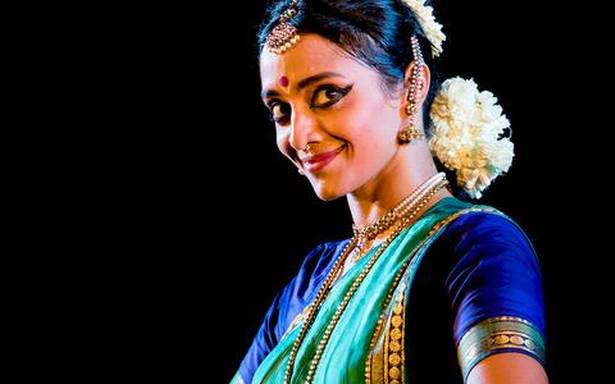Lakshmi’s use of the stage and of adavus was in her guru’s trademark style
It looked like Lakshmi Parthasarathy Athreya had wings on her feet as she moved across the wide expanse of the stage in her entry piece ‘Jaime jaime’ (Gambhira Nattai, tisra Adi). She effortlessly maintained the high energy levels through her recital for The Music Academy, following her guru Chitra Visweswaran’s vibrant style, which highlights ideas of space, natyarambha and adavus in diagonal lines.
The dancer also presented her guru’s choreographies, making the pieces her own with the degree of passion and joy she brought to the performance.
Mature treatment
The 34-minute Swati Tirunal kriti ‘Anjaneya Raghurama Dhoota’ (Saveri, adi) was the standout piece. The music was the bedrock and vocalist G. Srikanth along with Mudicondan Ramesh (veena), B. Sruthisagar (flute) and B. Ananthakrishnan (violin) gave the composition depth, allowing for the adjustments necessary to enhance the theatrics of Bharatanatyam.
Guru Chitra’s nattuvangam was elegant, with muted cymbals and a calm, stately rendering of the old jathis that seemed to enhance the lilt in them. The mridangist Venkatasubramanian’s sharp jathi accompaniment enhanced the nritta. The traditional Trikala jathi and the next, ‘Thadikku didikku dingu’ sounded musical in their rhythm and delivery. The third was an intriguing tisra-chatusra combination, that was executed on point.
Describing Hanuman
The pallavi detailed the ‘Sundarakandam,’ with Hanuman and his adventures in Lanka. It was not an indulgent storytelling session; the constraints with regard to the music were respected and the salient points alone highlighted. In one charanam, the child Hanuman’s attempts to frighten the sun were described. There were other such moments — when Hanuman is caught and dragged by the tail in Lanka, when he allows his tail to be set on fire, when he assumes a gigantic form and sets Lanka on fire.
In the episode that describes the Sanjeevani mountain being carried by Hanuman during the charanam ‘Vimala Mahaushadhi’, Lakshmi maintained the one-legged pose, Ekapadasana in yoga, for about 10-15 seconds to depict Hanuman in flight, a segment that would have drawn applause in a live show. The kalari movements she used for the ensuing fight showed the dancer’s fitness and body conditioning.
A blushing young nayika in love with Nataraja in ‘Theruvil varano’ (Khamas, rupakam, Muthu Thandavar), where she dreams of Shiva glancing at her while passing by was well performed. Meera’s ‘Pyare darsan deejo’, tuned by R. Visweswaran in Bhairav raag (adi tala), featured the distraught devotee who cannot bear separation from god and eventually merges with Krishna. Srikanth’s singing was emotive yet unobtrusive. Lakshmi concluded with a Hindolam thillana (adi, Madurai N. Krishnan), dancing with the same zest with which she had begun.
The Chennai-based writer reviews classical dance.
Source: Read Full Article

